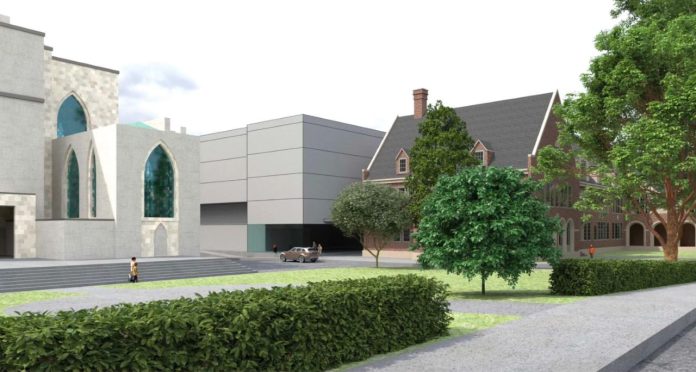
Church officials cited multiple headwinds against development for delaying housing and renovation plans for the historic Nicholas School.
Back in March 2023, after months of exploratory work, the vestry at St. Mark’s Episcopal Cathedral in Seattle unanimously voted in favor of converting the St. Nicholas property for affordable housing. In March 2024, they initiated the developer selection process and released plans to create more than 100 affordable units at 10th Avenue E and Galer Street while preserving the historic St. Nicholas building.
However, progress has stalled, which St Mark’s attributed to a “perfect storm” of issues creating headwinds for the project and larger affordable housing development system. The church anticipates keeping the project on hold, at least for the next two years.
Prior to deciding on affordable housing, St. Mark’s had explored market-rate housing on the site from 2020 to 2022. Ultimately, documents and spokespeople from St. Mark’s indicated they decided to shift to affordable housing for three main reasons:
- The cathedral determined market-rate housing would not generate as much revenue as originally projected.
- Affordable housing better aligned with the cathedral’s spiritual values.
- Affordable housing would generate enough revenue to preserve and maintain the St. Nicholas historic site.
In 2021, the Seattle City Council passed a package of zoning and regulatory incentives intended to encourage affordable housing development on properties owned by religious institutions, even if they are located in Neighborhood Residential zones dominated by single family homes. Those incentives are responsible for the project’s financial viability.
The Nicholas School is located within an area of North Capitol Hill zoned either Neighborhood Residential and Low-Rise 1, neither of which is normally compatible with apartment buildings. Despite extensive apartment construction to the south, closer to Capitol Hill’s light rail station, development activity has been very limited in the neighborhood surrounding St. Mark’s. The ability to use the religious property bonus and other incentives uniquely creates an opportunity for an apartment building of significant size in a neighborhood that has otherwise pursued zoning blocking such opportunities.
St. Mark’s has worked with the architecture firm atelierjones to create a range of options, and is leaning towards one which utilizes the height of the historic 1926 St. Nicholas structure, while replacing the later 1950s addition to the complex with five stories of residential units.
This “Adaptive Re-Use + Addition” plan would provide 119 units, while preserving the historic St. Nicholas structure by converting it to host affordable housing. The plan requires approval from the Landmarks Board pursuant to Seattle’s land use code, and St. Mark’s has met with the board to receive input on how to ensure the project is acceptable. More formal approval will come after a developer is able to commit to the project and more specific plans are finalized.
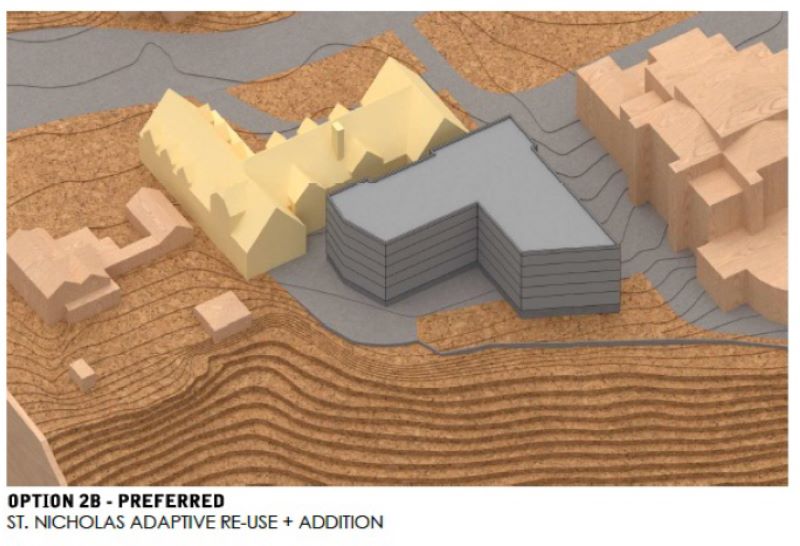
If the Seattle Landmarks Preservation Board doesn’t grant approval for the addition, the alternative is to replace the previous addition with 4 stories of affordable housing, the “Adaptive Re-Use + New Build” plan. This plan relies on the aforementioned ordinance that increases the allowed height of affordable housing on land owned by religious organizations.
“The more housing we can build here, the more into the feasibility zone we get financially,” a presenter on behalf of St. Mark’s said when discussing the alternatives at a meeting on June 5th. While the four-story addition would decrease the density and financial viability of the project as compared to the five-story plan, it would preserve the St. Nicholas site while complying with zoning regulations.
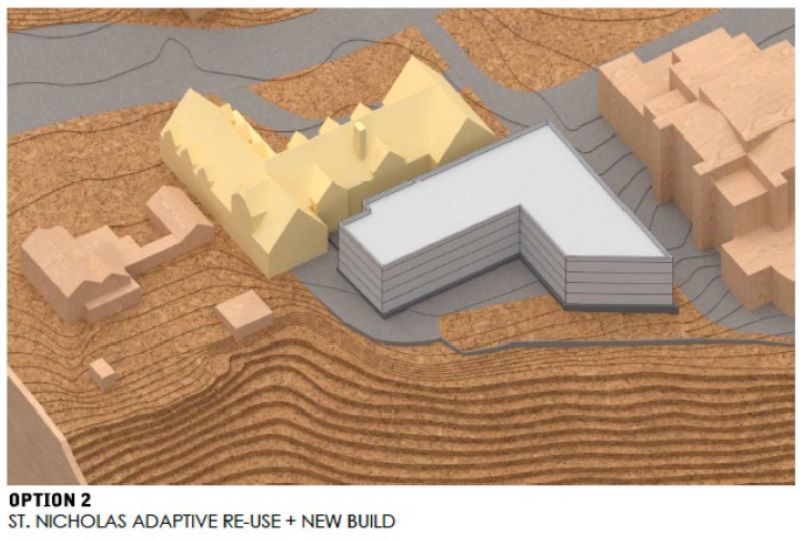
Members of St. Mark’s want to generate a sense of community with the project, and to this end see the immense cost of preserving the St. Nicholas site as worthwhile – millions, according to Rev. Steven Thomason, St Mark’s dean and rector. Still, the plan to create the most housing on the property, 134 units, is being retained in case future impediments rule out historic preservation. Though this would represent the most fiscally compelling option, the St. Nicholas site’s value as a community hub and historical landmark weigh heavily on the decision making process. For now, Thomason said St. Mark’s is least likely to pursue this option.
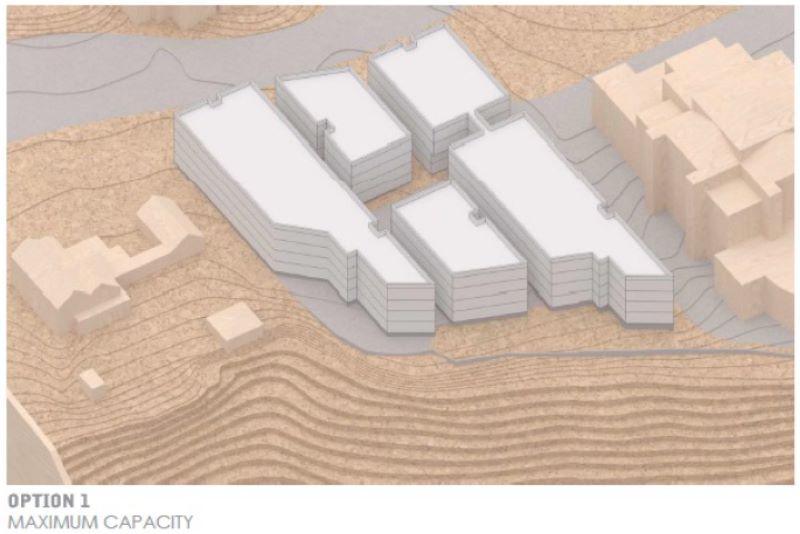
Preserving the St. Nicholas historic site is also seen as a means of ingratiating the development with surrounding residents, who Thomason indicated are broadly supportive. Community enthusiasm and acceptance came as a welcome surprise to the people at St. Mark’s, as the development would represent a major expansion of affordable housing in an area that has very few options for all but the wealthiest Seattleites.
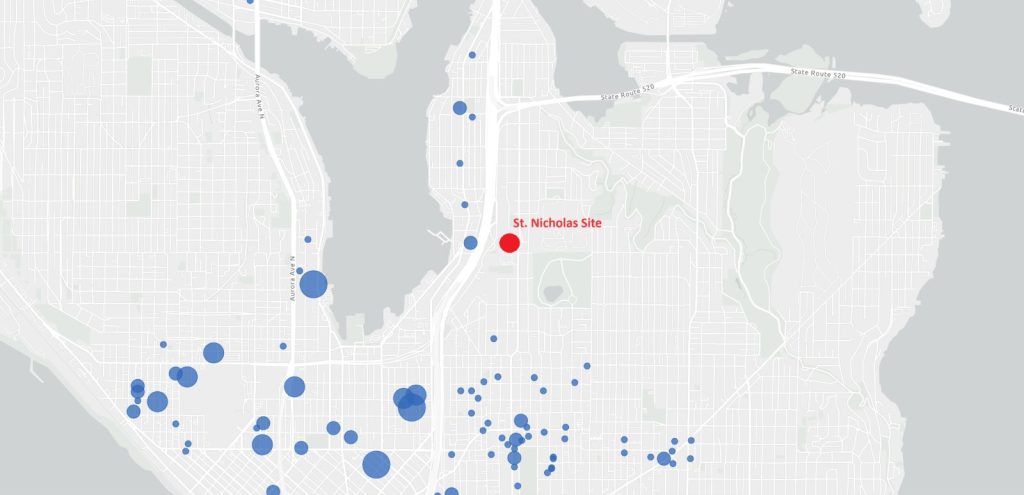
The preservation route would involve the removal of at least eight trees which now stand between the parking lot and the 1950s addition, but it would retain the gargantuan ones along the street and along the slope at the back of the lot. Pedestrianizing the front of the building while retaining the brick walls, stone arches, and significant tree cover are all seen as means of contributing to the sense of community St. Mark’s hopes to foster with this development.
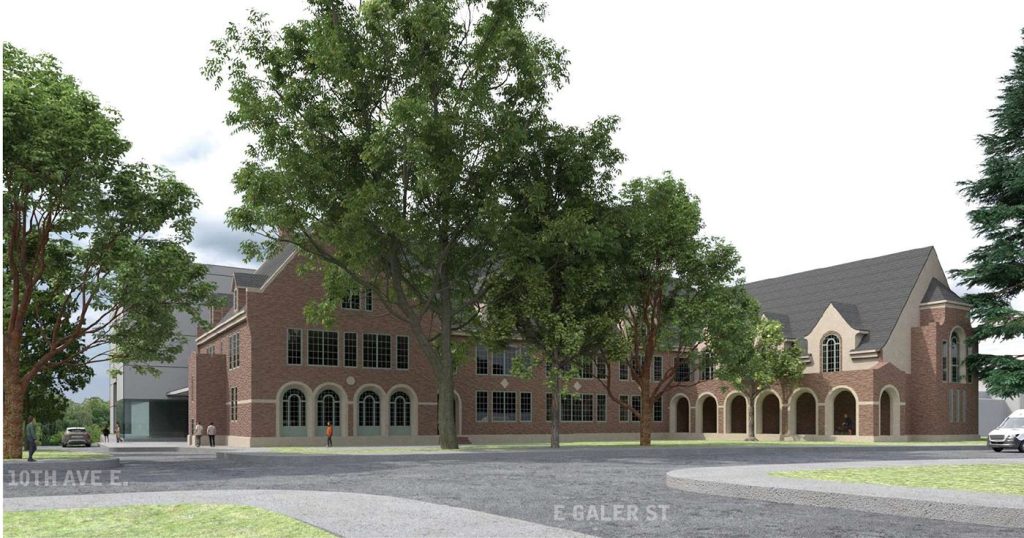
Part of the planning process has also involved environmental stewardship within the Episcopal doctrine of “creation care,” by ensuring the building meets International Living Future Initiative standards for construction. Reaching these standards will raise the project’s cost, but Thomason said St. Mark’s is firmly committed to them as the gold standard of sustainable construction.
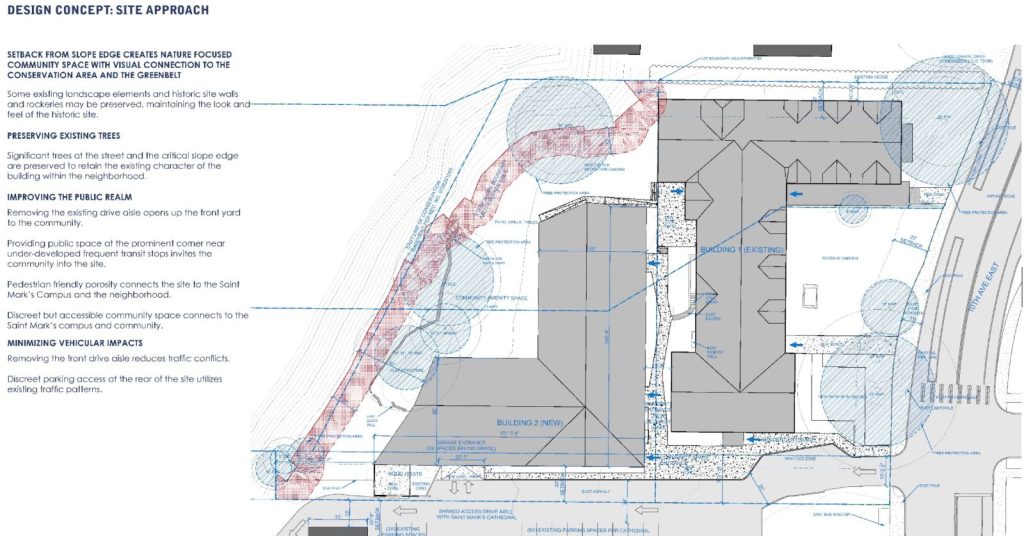
Thomason further indicated that walkable amenities and public transportation are integral parts of this project. The Route 49 bus stop just outside the building is useful for connecting to the University of Washington, downtown, or the Capitol Hill light rail station a mile to the south.
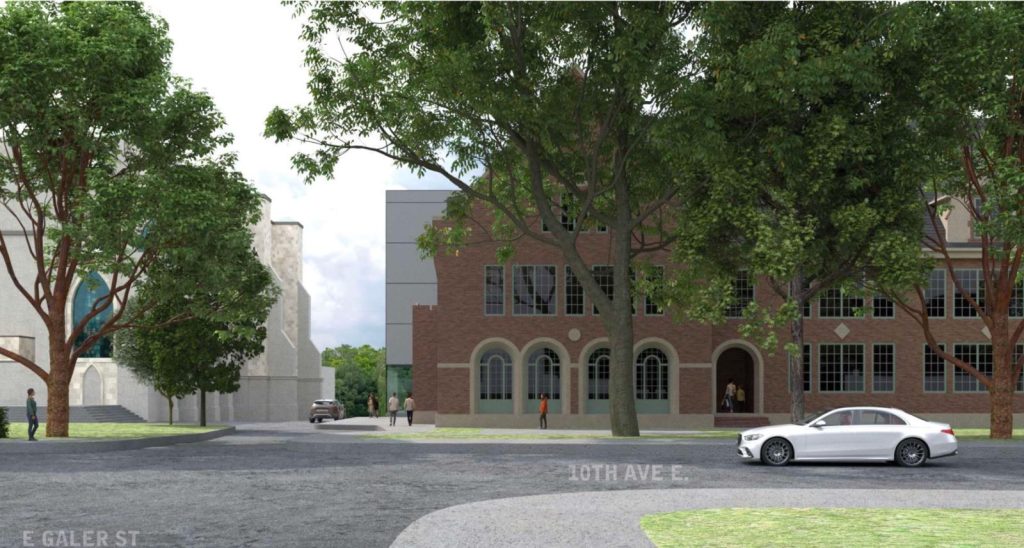
Members of St. Mark’s vestry, staff, and congregation expressed a desire to cater to families who might utilize the property, and Rev. Thomason highlighted the presence of schools within walking distance as appealing to potential residents. Stevens and Lowell elementary schools are both within a mile of St. Nicholas, barring either falling victim to Seattle Public Schools’ school closure plan.
Despite a prestigious project in a prime location owned by an institution fully committed to providing sustainable affordable housing in the midst of a housing shortage, challenges remain in a housing market facing considerable headwinds. Thomason called it a “perfect storm of market realities,” and provided the following reasons:
- Developers anticipated lower interest rates when initiating projects currently under development.
- Affordable developers are competing with higher-margin market-rate developers for limited capital.
- A limited amount of tax credits for affordable housing developers.
- Increased construction costs due to inflation.
- Increased projected operating costs, which he linked to higher security costs and higher incidence of non-payment of rent among tenants.
“The Seattle Office of Housing has met with St. Mark’s and their consultant to talk about this development,” said Nona Raybern, communications manager for the Seattle Office of Housing. “We understand that St. Mark’s attempted to find a developer through a Request for Proposals (RFP), but many affordable housing developers are engaged with their own priorities and pipelines, making it challenging to take on new projects.”
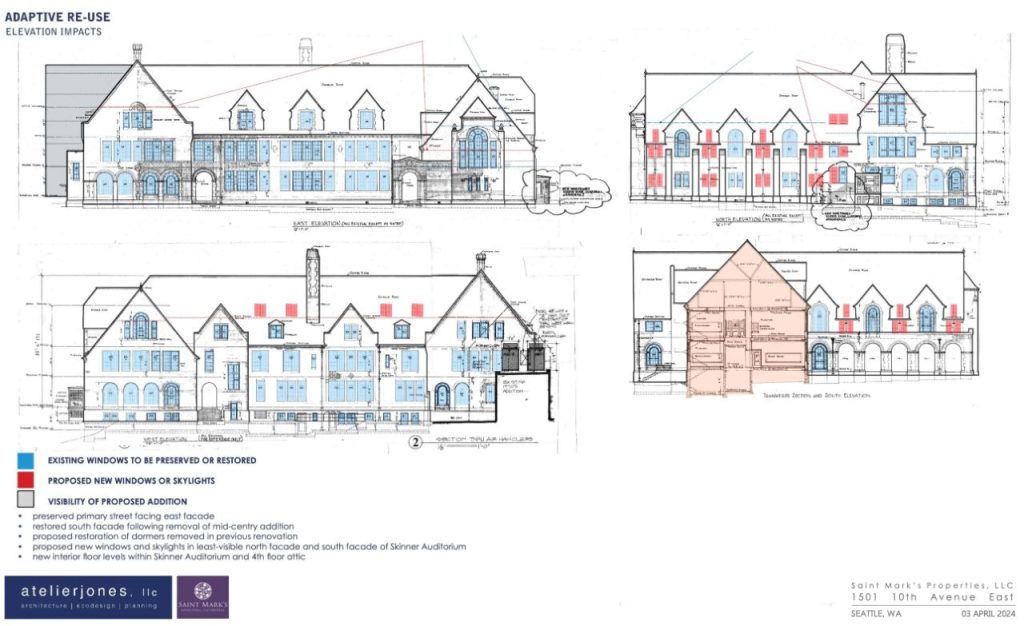
Thomason and Raybern separately expressed that the need for affordable housing outstrips capacity to create it, and continues to hit constraints.
“There is significant need for affordable housing in Seattle, and there are not currently enough local, state, or federal funding resources for us to meet the current or projected housing need through new development.” Raybern said. “Not only have the costs of materials significantly risen, but rising insurance, interest rates, and operating costs have also made the operation of housing more expensive. The Seattle Office of Housing values St. Mark’s interest in affordable housing. ”
The shortage is greater than existing affordable housing proposals can address, and simply jumpstarting lagging projects won’t be enough. “It’s not enough to open the floodgate and meet the needs of all the projects out there,” Thomason said.
The need is still strong, and Seattle’s housing market captures that reality in the form of some of the highest rents in the country, with the rate for a one-bedroom apartment trailing only New York, Boston, DC, and several Californian cities.
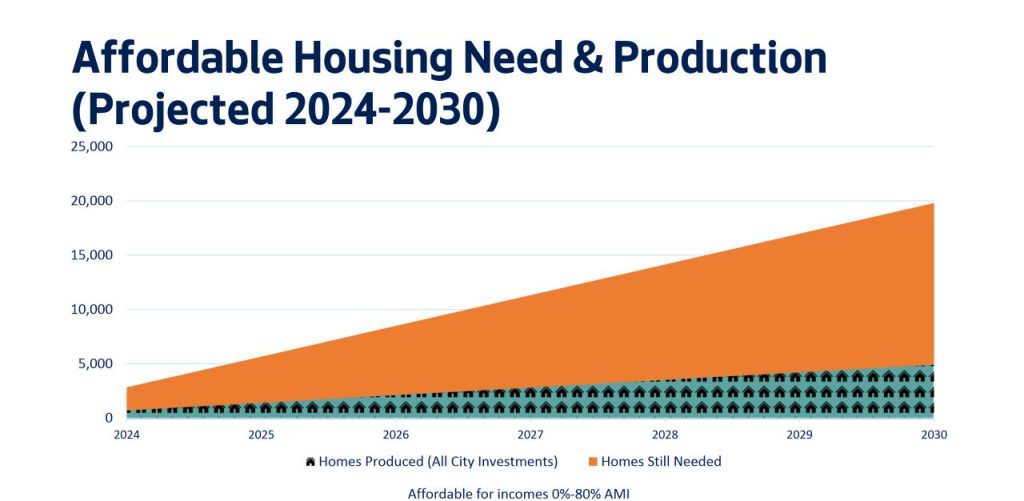
Thomason and St. Mark’s haven’t weighed in on Initiative 137, which raises funding for Seattle’s publicly-owned social housing developer. Raybern is optimistic about the initiative: “I-137 would potentially support the development and operation of social housing, which could possibly work for this project if it met the social housing priorities and criteria.”
St. Mark’s will need to maintain the property while it languishes in development limbo. In spite of the financial burden this delay places upon them, the cathedral remains committed to weathering this storm and moving forward with affordable housing.
St. Mark’s spiritual mission plays a role in this decision, as Thomason stressed back in September of 2023: “What we are really after is to try to determine how we can be best [sic] stewards of the land we’ve been given or entrusted with during our particular generation, on this place, in this place, and the opportunity for us to do so with a full measure of grace and commitment to our gospel core values.”

Collin Reid
Collin Reid is an educator who moved to the Central District of Seattle in 2024 after having lived and worked in St. Petersburg Russia for eight years. His background in political science and international experiences led him towards urbanism and transportation as the foundational elements of society. He is a member of the Seattle Democratic Socialists of America.

